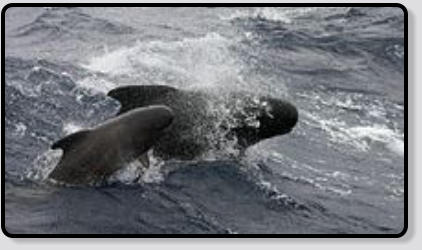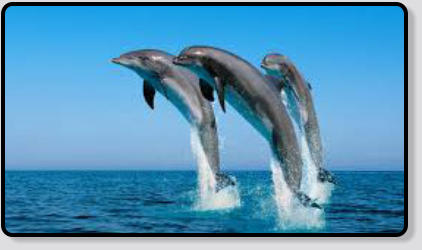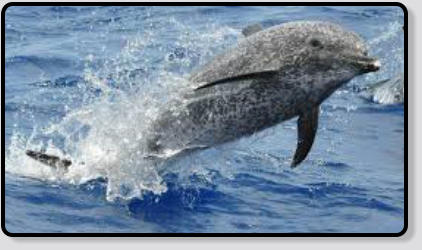Scientific classification
Kingdom:
Phylum:
Chordata
Class:
Mammalia
Order:
Artiodactyla
Family:
Delphinidae
Genus:
Globicephala
Species:
G. Melas
Binomial name (link Wikipedia)




Pilot Whale
Baleine Pilote
Pilotwal
Ballena Piloto
Griend

Description
Pilot whales get their name from the belief that there was a "pilot" or lead individual in their groups. The name for the genus, Globicephala is derived from a
combination of the Latin words globus ("globe") and kephale ("head"). The specific name, melas, is Greek for "black". This species has also earned the
nickname of pothead whale in some places because the shape of its heads reminded early whalers of black cooking pots. Long-finned pilot whales are
commonly referred to as blackfish, which is a named shared with several other large dolphin species including short-finned pilot whales, killer whales, false
killer whales, pygmy killer whales, and melon-headed whales.
This species was first classified in 1809 by a man named Thomas Stewart Traill and given the name Delphinus melas. However, this scientific name was
changed later to Globicephala melaena. Then in 1986, the specific name for this species was reverted to its original form melas.
The sexes are dimorphic, with females reaching lengths of up to 5.8 meters and 1800 kg (1.8 long tons; 2.0 short tons), while males are significantly larger
at up to 7.6 meters and 3,500 kg (3.5 long tons; 3.7 short tons).

Animalia
Scientific classification
Kingdom:
Phylum:
Chordata
Class:
Mammalia
Order:
Cetartiodactyla
Family:
Delphinidae
Genus:
Tursiops
Species:
T. Truncatus
Binomial name (link Wikipedia)




Common Bottlenose Dolphin
Dauphin Commun
Gemeinsame Große Tümmler
Delfín de Bottlenose Común
Tuimelaar

Description
Tursiops truncatus, commonly known as the common bottlenose dolphin or the Atlantic bottlenose dolphin (and in older literature simply as the
bottlenose dolphin, a term now applied to the genus), is the most well-known species from the family Delphinidae.
Common bottlenose dolphins are the most familiar dolphins due to the wide exposure they receive in captivity in marine parks and dolphinaria,
and in movies and television programs. T. truncatus is the largest species of the beaked dolphins. They inhabit temperate and tropical oceans
throughout the world, and are absent only from polar waters. All bottlenose dolphins were previously known as T. truncatus, but recently the
genus has been split into three species, T. truncatus, T. aduncus (Indo-Pacific bottlenose dolphin) and T. australis (Burrunan dolphin). Although T.
truncatus has been traditionally called the bottlenose dolphin, many authors have used the name common bottlenose dolphin for this species
since two other species of bottlenose dolphins were described. The dolphins inhabit warm and temperate seas worldwide. Considerable genetic
variation has been described among members of this species, even between neighboring populations, and so many experts believe multiple
species may be included within T. truncatus.
The common bottlenose dolphin is grey in color and may be between 2 and 4 m (6.6 and 13.1 ft) long, and weighs between 150 and 650 kg (330
and 1,430 lb). Males are generally larger and heavier than females. In most parts of the world, the adult's length is between 2.5 and 3.5 m (8.2
and 11.5 ft) with weight ranging between 200 and 500 kg (440 and 1,100 lb). Newborn calves are between 0.8 and 1.4 m (2 ft 7 in and 4 ft 7 in)
long and weigh between 15 and 30 kg (33 and 66 lb). They can live as long as 40–50 years. Sexual maturity varies by population, and ranges
from 5–14 years of age. Dolphins have a short and well-defined snout that looks like an old-fashioned gin bottle, which is the source for their
common name. Like all whales and dolphins, though, the snout is not a functional nose; the nose has instead evolved into the blowhole on the
top of their heads. Their necks are more flexible than other dolphins' due to five of their seven vertebrae not being fused together as is seen in
other dolphin species.
Animalia

Categories: Whale & Dolphins
Harry van Goor 2016
source: Wikipedia, the free encyclopedia


Scientific classification
Kingdom:
Phylum:
Chordata
Class:
Mammalia
Order:
Cetacea
Family:
Delphinidae
Genus:
Stenella
Species:
S. Frontalis
Binomial name (link Wikipedia)




Atlantic Spotted Dolphin
Atlantique, Tacheté
Zügeldelfin
Stenella Frontalis
Gevlekte Dolfein

Description
The Atlantic spotted dolphin (Stenella frontalis) is a dolphin found in the Gulf Stream of the North Atlantic Ocean. Older members of the species
have a very distinctive spotted coloration all over their bodies. The Atlantic spotted dolphin was first described by Cuvier in 1828. Considerable
variation in the physical form of individuals occurs in the species, and specialists have long been uncertain as to the correct taxonomic
classification. Currently, just one species is recognised, but a large, particularly spotty variant commonly found near Florida quite possibly may be
classified as a formal subspecies or indeed a species in its own right.
Atlantic spotted dolphins in the Bahamas have been observed mating with bottlenose dolphins. Rich LeDuc has published data that suggest the
Atlantic spotted dolphin may be more closely related to bottlenose dolphin (genus Tursiops) than to other members of the genus Stenella.
The coloring of the Atlantic spotted dolphin varies enormously as it grows, and is usually classified into age-dependent phases known as two-
tone, speckled, mottled, and fused. Calves are a fairly uniform gray-white, with one or no spots. When they are weaned, speckling occurs,
typically between 3 and 4 years and lasting for an average of 5 years. A juvenile is considered mottled when it develops merging gray and white
spots on the dorsal surface and black spots on the ventral surface. This usually happens between age 8 or 9. A fused pattern is reached when
dark and white spots are on both the ventral and dorsal sides. As the animal matures, the spots become denser and spread until the body
appears black with white spots at full maturation.
Animalia



